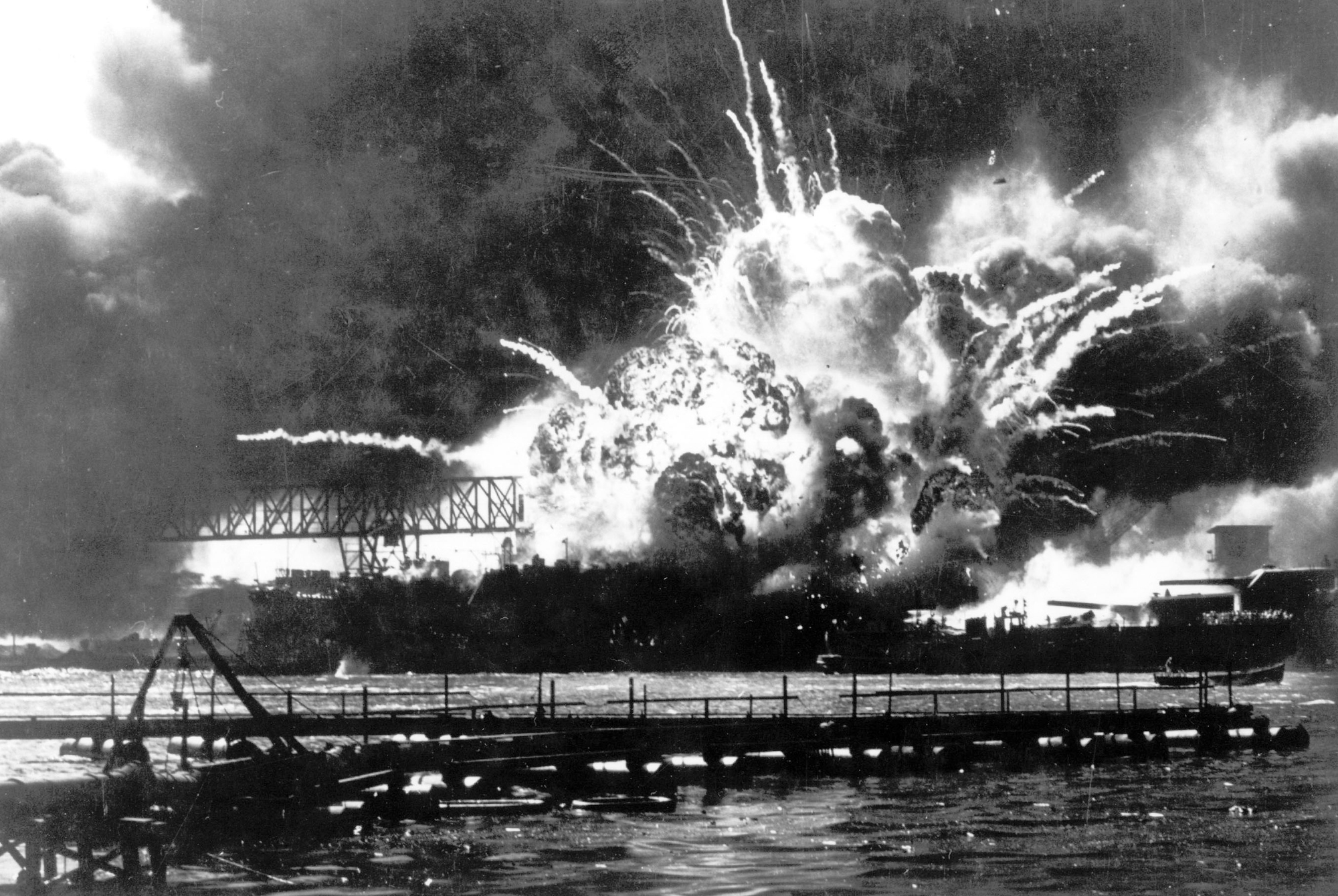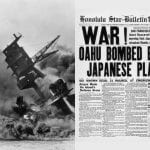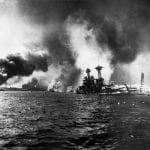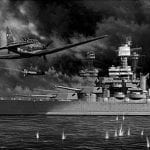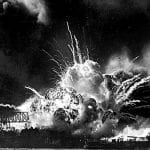The following article on who attacked Pearl Harbor and why is an excerpt from John Koster’s Operation Snow: How a Soviet Mole in FDR’s White House Triggered Pearl Harbor. Using recently declassified evidence from U.S. archives and newly translated sources from Japan and Russia, it presents new theories on the causes of the Pearl Harbor attack. It is available to order now at Amazon and Barnes & Noble.
When the news about Pearl Harbor reached Washington, President Roosevelt was thunderstruck—not because he was surprised by the attack itself, but because the attack had been far more dreadful than anything the administration had expected. Secretary of Labor Frances Perkins, who saw him at a cabinet meeting that day, said that Roosevelt “could hardly bring himself to describe the devastation. His pride in the Navy was so terrific that he was having actual physical difficulty in getting out the words that put him on the record as knowing that the Navy was caught unawares.” While Roosevelt himself had probably not actively conspired to provoke the Japanese, the Hull note had made war all but unavoidable, and he had done little to interfere.
Henry Stimson, the secretary of war, looking over the flurry of decoded documents, had known that war was about to break out. His concern was that the Japanese fire the first shot so Japan would be branded the aggressor by world opinion. And Harry Dexter White, of course, had intended to provoke the Japanese beyond any hope of peace.
When the final part of the war message arrived at the Japanese embassy, the typists had all gone home and the diplomats themselves—horrified by the prospect of war—had gotten so drunk the night before that they could not get the declaration of war typed in time. Kurusu and Nomura dropped it off as the planes were returning to their carriers from the smoking wreckage of the Pacific Fleet.
The Japanese message read in part, “It is a fact of history that the countries of East Asia for the past hundred years or more have been compelled to observe the status quo under the Anglo-American policy of imperialistic exploitation and to sacrifice themselves to the prosperity of the two nations.” Cordell Hull was not ready for that kind of talk from “colored people.” “In all my fifty years of public service I have never seen a document that was more crowded with infamous falsehoods and distortions—infamous falsehoods and distortions on a scale so huge that I never imagined until today that any government on this planet was capable of uttering them,” Hull said tersely. Privately, Hull referred to Kurusu and Nomura as “scoundrels and piss-ants.” Franklin Roosevelt’s own family, however, lent at least some credibility to the historical allegations in the Japanese declaration of war, for the Delanos had made a huge fortune in the Chinese opium trade. However much Hirohito’s government had made Showa Japan hated throughout Asia, the declaration accurately depicted the history of Western relations with the East as all Asians understood it.
The garrison in the Phillipines heard about Pearl Harbor while the attack was still in progress and had gone on the alert. It was there at 12:45 p.m. the following day, as thousands of red-blooded Americans rushed to volunteer and avenge the “sneak attack,” that the second act of the tragedy took place. The United States had hoped to have at least one hundred B-17s in the Philippines before war broke out. So far they had received thirty-five. These were the long-range fourengine bombers that Admiral Kimmel had wanted for armed reconnaissance around Hawaii but never got. The U.S. decided to attack the Japanese on Formosa, and the B-17s were called down to Clark Field to refuel and arm. While their pilots and gunners were lunching and the planes were refueling, a formation of two-engine Japanese bombers arrived and carried out a precision bombing run from twenty thousand feet. Clark Field exploded in flame and smoke, and eighteen of the twenty-one B-17s on the field were destroyed in a matter of minutes. Japanese Mitsubishi A6M Zero fighters zoomed in to strafe the P-40 and P-36 fighters at Eba and Nichols Fields. In addition to the B-17s at Clark, the Japanese destroyed fifty-three of the 107 U.S. fighters in the Philippines and thirty-five other supply and training aircraft, losing only seven of their own fighters.
Not a single U.S. fighter plane had been aloft to oppose them, and many of the surviving fighters were obsolete P-36 Seversky ships, secondstring aircraft that stood no chance against a Zero in a dogfight. Most of the P-36 fighters were destroyed in the next few days, and the fleet of P-40s—obsolescent if not obsolete—was whittled down until there were two left. The American infantrymen who called themselves “the Battling Bastards of Bataan—no Mama, no Papa, no Uncle Sam” referred to their two-plane air cover as the Lone Ranger and Tonto. When the Battling Bastards who survived the battle and the Bataan Death March were dying in Japanese prison camps of sekiri—tropical diarrhea with bloody stools—they wrote curses on the prison walls in their own fecal blood: “____ Roosevelt,” “____ MacArthur,” “____ the Japs.” As in his presidential campaigns, FDR came in first.
Faced with losses and humiliations they had not anticipated when they dictated unacceptable conditions to a proud but threatened nation—now enraged and filled with ferocious self-confidence—Roosevelt and the men around him began a frantic search for scapegoats.
Their first target was Admiral Husband Kimmel. As his predecessor Richardson had done, Kimmel had warned the president about the Navy’s lack of preparation for war. Roosevelt, however, did not warn Kimmel about the impending attack on Pearl Harbor—not even after he had read the decoded Japanese message on December 6. Ten days after the attack, Kimmel and General Walter Short were both demoted and replaced.
Kimmel saw it coming. As he watched the last phase of the attack on the morning of December 7, a spent .50-caliber slug from one of his fleet’s own antiaircraft machine guns hit Kimmel in the chest, shredded his white linen uniform, and tumbled to the ground at his feet. Kimmel stooped over, picked up the half-inch-wide bullet, and looked at it glumly: “It would have been merciful had it killed me.”
General Short took his demotion humbly. Kimmel—whom Roosevelt had appointed because he was a scrapper—fought for the rest of his life to win exoneration. “The Pacific Fleet deserved a fighting chance,” Kimmel wrote in Admiral Kimmel’s Story, published in 1954. “Had we had as much as two hours of warning a full alert of planes and guns would have greatly reduced the damage. We could possibly have been able to locate the Jap carriers, and our own carriers Lexington and Enterprise already at sea to the westward of Oahu might have been brought into the picture instead of expending their efforts to the southward as a result of faulty information. The great intangible, the element of surprise, would have been denied the Japs.”
The question whether Kimmel was substantially to blame for a lack of vigilance remains open. But why didn’t the White House or the War Department telephone Hawaii when the president read a decoded message that said, “This means war”? That question is unanswered by anything Kimmel did or did not do.
Pearl Harbor had been an obvious target—so obvious, in fact, that John Huston was at work at the time on a movie about a fictional Japanese air attack on Pearl Harbor. After the attack, Huston scurried to change the target in the film from Pearl Harbor to the Panama Canal. The film kept its original title, Across the Pacific, perhaps because it was almost completed when the Japanese struck. Had the film been released before the attack, Roosevelt’s embarrassment might have been even deeper than it was.
Searching to Find Who Attacked Pearl Harbor and Why
In an audience with Hirohito on December 26, Mitsuo Fuchida, Admiral Nagumo, Captain Osami Nagano, and the leader of the second wave of attackers at Pearl Harbor, Shigekazu Shimazaki, presented the emperor with photographs of the cataclysmic destruction of the Pacific Fleet. The audience was supposed to last for thirty minutes, but Hirohito was so fascinated by the photographs that he extended it to almost two hours.
“Are there any other questions, Your Majesty?” Nagano asked.
“Not particularly . . . ” the emperor replied. Then, after a few moments, he asked: “Are you going to take these pictures with you when you go?”
“We’ll put a cover on it and present it to Your Majesty later,” Nagano said.
“Oh, you could put the cover on later,” Hirohito replied. “I’d like to show this to the empress now.” The emperor shuffled away clutching ten photographs, and the warriors bowed obediently. Hirohito knew that the attack had saved his throne and his dynasty from revolution, at least for the time being, and he may have hoped that the catastrophes of Pearl Harbor and Clark Field had convinced the Americans to be reasonable. A pilot who had strafed Officer’s Row hoping to kill a few admirals had been harshly rebuked when he reported back to his carrier. The Japanese wanted the attack to be conducted with chivalry, as in the hostilities with Russia in 1904 and with the Kaiser’s forces in 1914, so they could negotiate a peace as honorable men and not as the rapists of Nanking.
Three days after the attack on Pearl Harbor, Henry Morgenthau Jr. asked J. Edgar Hoover what he thought about rounding up the entire Japanese and Japanese-American population of the west coast. Hoover was appalled and bluntly told Morgenthau that Attorney General Francis Biddle would not approve any “dragnet or round-up procedure.” Many of these ethnic Japanese were American citizens, Hoover reminded Morgenthau, and such an action would be illegal. He also knew that such a move was unnecessary. Based on information from loyal Japanese-Americans, including Togo Tanaka, and from Korean dissidents, including Kilsoo Haan, as well as information obtained by burglarizing the Japanese consulate in Los Angeles and the Black Dragon Society’s office, Hoover had a comprehensive list of people he wanted to arrest, and he had already started.
“We think the Japanese Government is stupid and has embarked on a campaign it has absolutely no chance of winning,” Togo Tanaka had written in a newspaper editorial published on December 8. The Japanese-American community “had not been in sympathy with Japan’s expansion program,” he insisted. Tanaka was arrested the same day, with no explanation, and was in custody as Hoover spoke to Morgenthau and opposed a wholesale round-up. Tanaka was held for eleven days and then released without formal charges or an explanation. Officials from the War Department—more political than the FBI and less informed about legality—had interrogated Tanaka about his loyalties earlier when he had asked if his bilingual newspaper could keep publishing in case of war with Japan.
Tanaka estimated that about 5 percent of the Japanese-born population might be suspect. He divided the suspects about evenly into aka, “reds,” who tended to be educated but unsuccessful, and ultra-nationalists, who tended to be thick-headed and unable to learn English. Within three weeks of the attack on Pearl Harbor, the FBI, the Bureau of Naval intelligence, and the Bureau of Army Intelligence had arrested 2,192 Japanese within the continental United States and another 879 in Hawaii. Some of these people were actually dangerous—even under detention, Japanese fanatics murdered a couple Japanese-Americans for their loyalty to the United States—but many others were simply victims of circumstance.
On March 18, 1942, Roosevelt signed Executive Order 9102, establishing the War Relocation Authority, which Senator Robert Taft called the sloppiest criminal law he had ever heard of. Japanese-Americans born and raised in the United States, many of them Christians, many of them graduates of American high schools and colleges, were moved on a few days’ notice to ten concentration camps in isolated mountain and desert locations. Some collapsed of heat stroke before they arrived at the hastily constructed tar-paper and clapboard barracks, where multiple families shared a single room.
By June 7, 112,000 American men, women, and children were interned behind barbed wire, eating wretched food in harsh climates. About a dozen inmates were shot dead by guards, and many others were beaten, sometimes to avenge a fallen brother or friend, sometimes because they wandered outside the safety zone, often trying to catch fish to supplement their rations. Many elderly Japanese succumbed to culture shock and simply gave up the will to live. Eleanor Roosevelt spoke out against the internments—the relocated Japanese artist Chiura Obata sent her one of his paintings as a sign of gratitude—and Attorney General Biddle moved behind the scenes to liberalize a release program for Japanese-Americans who could prove their loyalty.
On December 11, 1941, four days after Pearl Harbor, Hitler spontaneously declared war on the United States. With the Wehrmacht at the gates of Moscow and Leningrad, Russian morale was crumbling. NKVD detachments were being placed behind Red Army positions to shoot deserters. Then hundreds of thousands of reinforcements and more than a thousand tanks arrived from Siberia and Mongolia, freed up by the Japanese war with the United States. Snow fell at the same time, and the Russians stopped the Wehrmacht in its tracks, saved Moscow and Leningrad, and drove the Germans into a limited retreat.
Vitalii Pavlov’s lunch date with Harry Dexter White at the Old Ebbitt Grill might have been the Soviets’ most important strategic maneuver.
On January 20, 1942, SS-Obergruppenführer Reinhard Heydrich convened a conference at Wannsee, a suburb of Berlin, to plot the fate of Europe’s Jews. Heydrich must have known, though he did not mention it, that with both Russia and America in the war and with the German invasion of Russia repulsed, Germany faced a long and perhaps unwinnable war. The large-scale relocation of the millions of Jews now under the control of the Third Reich was no longer practicable, and Heydrich presented a program of extermination.
Under proper guidance, in the course of the final solution the Jews are to be allocated for appropriate labor in the East. Able-bodied Jews, separated according to sex, will be taken in large work columns to these areas for work on roads, in the course of which action doubtless a large portion will be eliminated by natural causes. The possible final remnant will, since it will undoubtedly consist of the most resistant portion, have to be treated accordingly, because it is the product of natural selection and would, if released, act as the seed of a new Jewish revival. See the experience of history.
Thus with a nod to Darwin, Heydrich signed the death warrant of the Jews as a race. He exempted those over sixty-five because they were unlikely to breed and those who had been crippled or decorated in World War I for patriotic reasons. Everyone else was to be murdered. Pearl Harbor had saved Stalin. After determining who attacked Pearl Harbor and why, the entry of America into the war, with the maniacal cooperation of Hitler, had touched off the Final Solution.
This article on who attacked Pearl Harbor and why is part of our larger selection of posts about the Pearl Harbor attack. To learn more, click here for our comprehensive guide to Pearl Harbor.
 |
 |
This article is from the book Operation Snow: How a Soviet Mole in FDR’s White House Triggered Pearl Harbor © 2012 by John Koster. Please use this data for any reference citations. To order this book, please visit its online sales page at Amazon or Barnes & Noble.
You can also buy the book by clicking on the buttons to the left.
Cite This Article
"Who Attacked Pearl Harbor and Why: America’s Search for Scapegoats After the Attack" History on the Net© 2000-2024, Salem Media.
April 18, 2024 <https://www.historyonthenet.com/who-attacked-pearl-harbor-and-why>
More Citation Information.



